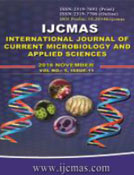


 National Academy of Agricultural Sciences (NAAS)
National Academy of Agricultural Sciences (NAAS)

|
PRINT ISSN : 2319-7692
Online ISSN : 2319-7706 Issues : 12 per year Publisher : Excellent Publishers Email : editorijcmas@gmail.com / submit@ijcmas.com Editor-in-chief: Dr.M.Prakash Index Copernicus ICV 2018: 95.39 NAAS RATING 2020: 5.38 |
The diversity of bacterial communities in the formation waters of ten oil reservoirs from western India was analyzed by PCR – Denaturing Gradient Gel Electrophoresis (DGGE). 16S rRNA gene fragments of the bacterial community were PCR amplified using universal primers targeting V3-V5 eubacterial hyper-variable regions. The phylogenetic analysis revealed that formation water metagenome mainly constituted bacteria, showing similarity to Paracoccus, Brachymonas, Hydrogenophaga, Bacillus, Pelomonas, Thalasospira and Pseudomonas. Many of the bacterial sequences shared less than 95% homology with the reference sequences available in Gen-Bank database, hence; some of these could represent novel species/ genera. Application of statistical indices such as Simpson's index (1- D) and the Shannon-Weaver index (H) to the well resolved DGGE pattern of 16S rR NA gene fragments revealed more diversity of bacteria in S7 and S9 samples, whereas equitability (J) data indicated that population was not dominated by any species. It was also observed that formation water consisted of predominantly the proteobacteria capable of nitrate reduction and hydrocarbon degradation.
 |
 |
 |
 |
 |